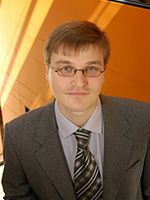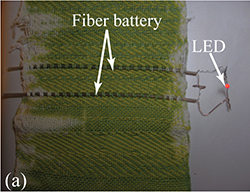
Photonics ● Mi-IR 7 THz ● Smart Textiles ● Waveguides
Professor Maksim Skorobogatiy specializes in mid-IR and THz photonics (optical fibres and waveguides), optical sensors and smart textiles.
He holds the Tier I Canada Research Chair in Ubiquitous Terahertz Photonics.
Photonics, research & industry
Professor Skorobogatiy has expert knowledge of manufacturing, characterization and modelling of photonic crystal fibres. This class of fibres is of interest to industries in fields such as communications, biophotonics, electronics (optical sensor), plasmonics, as well as mid-infrared (mid-IF) and terahertz (THz) photonics. Terahertz (THz) waves lie between infrared and microwave radiation on the electromagnetic spectrum.
Some examples of Professor Skorobogatiy’s work include development of a subwavelength waveguide for THz communications, imaging and detection; concept design of a novel plasmonic THz biosensor (microstructured fibres with nanoscale metallic inclusions); and creation of porous microstructured optical fibres from biodegradable materials. The THz waveguides developed in his laboratory are also biocompatible and biodegradable, and require little energy to function. A patent has also been filed for his SPR biosensor based on a photon crystal waveguide. One of his students has also developed an E. coli bacteria detector that uses THz optical fibre.
In the area of smart textiles, Professor Skorobogatiy collaborates with chemists, artists, engineers and physicians. To get around the constraints of fabric, he has developed innovations such as a flexible Li-Ion battery using nanostructured ionized electrodes, which can be incorporated into clothing. He has also designed sensors for automobiles and woven 2D touchpad sensors, and merged fibre-optic and textile technology to make clothes that literally light up (or flexible advertising billboards)! The industrial applications of his research have led, among other things, to close collaboration with CorActive Inc., a company specializing in design and manufacturing of optical fibres for military and commercial use. Together they have built a laboratory dedicated to the design, manufacturing and commercialization of mid-IR fibres (using chalcogenide glass, for example).
|
|
international collaborations
Lastly, Professor Skorobogatiy has authored and co-authored two published books: Nanostructured and Subwavelength Waveguides: Fundamentals and Applications (Wiley, 2012) and Fundamentals of Photonic Crystal Guiding (Cambridge University Press, 2009). He is also involved in international collaborations, as a Fellow of the Japanese Society for Promotion of Science, and was a member of a Québec trade mission to Japan in 2007.




